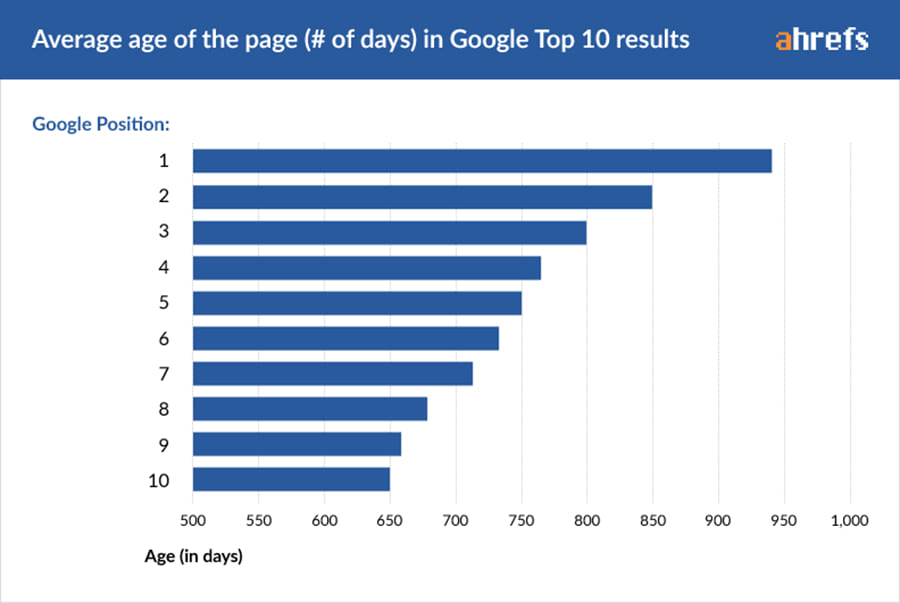
The number one struggle I face with pitching clients and showing them the value of SEO, is that it takes time. Whereas pay-per-click advertising and social media can be spun up relatively quickly and provide a return on investment rather quickly, SEO is an annuity investment.
To make a relevant analogy: you can’t invest money in the stock market today and expect dividends tomorrow. The money you invest today is done so with the understanding that it will provide value later. SEO is similar.
Nevertheless, that’s a real problem because when clients are making a significant investment in SEO, they want to see results. That’s why I prepare clients by telling them “some of the work we do isn’t going to yield results right away. It’s going to take 6-12 months.”
This is especially true with publishing new content. Ahrefs did a study about how long it takes to rank in Google. They looked at the average age of pages ranking in positions 1-10, and the overall takeaway was that higher positions typically featured pages that have been live for several years. They also noted that higher authority sites took less time to rank well, which is a no-brainer. If there’s one single graph that shows their findings best, it’s this one:
That’s helpful, but does their large scale study align with actual first hand findings? Sure there’s value in a larger data sample, but having actual anecdotal data would certainly help reinforce those findings.
Fortunately I have that data. Across multiple clients in multiple industries, I can highlight examples of pages that rank well for target keywords, but didn’t reach full potential until months after they were published. I’m sharing these examples so that both consultants and clients can form realistic expectations for SEO campaigns, which is something I believe this industry can and should do a much better job at.
Example #1
Client Industry: Construction
Type of page: WordPress blog post
This particular page targeted “rental cost” keywords which are fairly low volume but highly relevant in the client’s industry. The client was hesitant to discuss pricing, but competitors were doing it, so we pushed them to create their own page. Not only does it drive meaningful traffic, but it has resulted in ~3 leads per month since it was published 16 months ago.
Example #2
Client Industry: Web hosting
Type of page: Resource center pages
These two pages were both created as part of a large content initiative – more than 120 pages of long form content over a one year period. Notably, they both saw steady growth and then marked increases in January 2018, possibly as a result of an algorithm update.
Example #3
Client Industry: Healthcare
Type of page: Core site page
This page saw long periods of inactivity in the very competitive healthcare space, before eventually moving into ranking positions that drive meaningful amounts of traffic (this is also a result of other improvements made to the site during that time).
Example #4
Client Industry: Local retail
Type of page: WordPress blog post
This example comes from a mom & pop retail store. A blog post that I wrote eventually moved into top ranking positions for some industry head terms, outranking even the brands that the retailer sold in their store. Unfortunately, the business owners did not continue digital marketing efforts after I left my position there, and the content did not retain its visibility in search results.
Example #5
Client Industry: Digital marketing
Type of page: WordPress blog post
The last example comes from my own website (which has lower site authority than any of my clients). While not initially a large traffic source, an analytics blog post I wrote moved into top positions (including the answer box) over a period of one year.
Summary
The key takeaway here is that firsthand data supports the study that Ahrefs did – that content may take months or more to move into top ranking positions, especially for competitive keywords. Site authority absolutely helps – two of the sites included here had domain authority ratings between 50 and 80, which is a rough indicator that they’re authoritative, especially in their respective industries.
With some of the examples, we did employ other tactics like building internal and external links. All pages were submitted to Google Search Console after publishing to make sure they got crawled as soon as possible. Also obvious is the fact that none of these pages were in a vacuum meaning that there were other marketing (and SEO) initiatives that could’ve contributed to better rankings. Nevertheless, there is a clear pattern showing that even highly optimized content on authoritative sites doesn’t always achieve top rankings immediately, and SEO continues to require patience.









This is a great explanation as to why you can’t expect results from SEO immediately. Pages need to time build a presence and obviously it takes a little bit for things to get shared around too. Example #4 is good proof point for showing why you need to keep up with SEO and not just write content and forget about it. You called out the increase in performance in January 2018 for all of these clients, likely due to a algorithm update, which makes sense, but they all also show a dip in traffic heading in January. Is this a seasonal decrease that generally happens to non-ecom/sales clients heading into the holiday/EOY rush or do you think it sorta had something to do with the impending algorithm update?